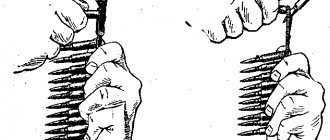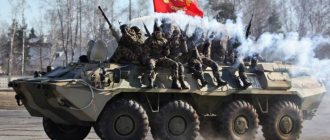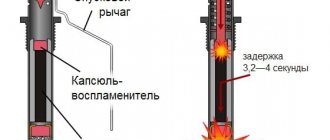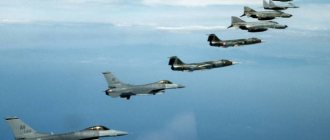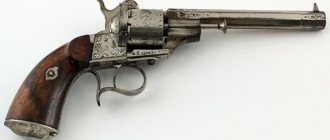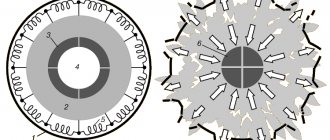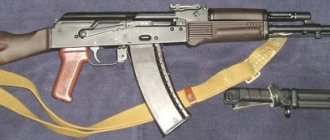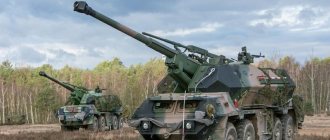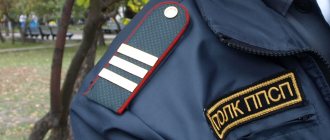Types of lethal weapons
When considering lethal weapons - what they are - it is worth highlighting several categories of weapons. First of all, you need to note edged weapons. This includes weapons that affect targets by contact in close combat. As for remote lethal weapons, firearms should be noted here, as well as weapons of mass destruction.
What is a weapon of mass impact?
This category contains:
- Nuclear lethal weapons. What is this? First of all, means whose action is based on the release of an impressive charge of nuclear energy, which spreads in the form of chain reactions. All this causes serious destruction and leads to radiation contamination of the area.
- Lethal chemical weapons are based on the destruction of enemy personnel through exposure to toxic substances.
- Incendiary weapons - involves the use of flammable bases: pyrogel, napalm, white phosphorus.
- Bacteriological lethal weapon - what is it? It is aimed at mass destruction of crops, animals and people by spreading pathogenic spores and organisms, all kinds of viruses, and toxic substances.
Notes[ | ]
- Russian police armed themselves with a “Stunner” // © Internet publication “Lenta.ru” (Lenta.ru) May 19, 2022.
- ↑ 1 2 3 Slyusar V.I.
NATO research system on the development of non-lethal weapons // Collection of materials of the VI International Scientific and Practical Conference “Problems of coordination of military-technical and defense-industrial policy in Ukraine. Prospects for the development of modern military technology.” - Kiev, 2022. - pp. 306–309. - Convention on the Prohibition of the Development, Production, Stockpiling and Use of Chemical Weapons and Their Destruction. - UN, 1993. - on the official website of the UN, on the official website of the OPCW. (Date accessed: September 18, 2020)
- The Long Range Acoustic Device™ (LRAD®) (unavailable link): [arch. 10/06/2008] // American Technology Corporation official website (www.atcsd.com). — Date of access: 05/02/2008.
- Poroskov N.
In search of “humane” weapons // Website of the magazine of the Ministry of Defense of the Russian Federation “Army Collection” (army.ric.mil.ru) January 01, 2022. - Chronology of historically significant treaties and agreements on disarmament and non-proliferation (1946–2006) (inaccessible link): [arch. 06/07/2012] // Official website of the UN (www.un.org). — Date of access: 09/18/2020.
- Slyusar V.I.
New in non-lethal arsenals. Unconventional means of destruction. // Electronics: science, technology, business: magazine. - 2003. - No. 2. - P. 60–66. - Slyusar V.I.
Generators of super-powerful electromagnetic pulses in information wars // Electronics: science, technology, business: magazine. - 2002. - No. 5. - P. 60–67. Archived from the original on May 16, 2014.
Ammunition
To suppress the advancing enemy force, grenades are used primarily.
According to their intended purpose, such ammunition is anti-tank and anti-personnel. The latter, in turn, are divided into high-explosive fragmentation and incendiary. Another common type of lethal ammunition is mines. There are several categories here:
- ground - activated upon contact with enemy personnel;
- anti-tank – used to destroy or disable armored vehicles;
- marine - designed to cause damage to underwater and surface vessels.
If we talk about missiles, the latter are used to destroy ground, air and water targets. In particular, torpedoes are used to destroy port facilities, hydraulic systems and sea vessels.
Lethal and non-lethal weapons
Non-lethal weapons are also known as “humane” weapons.
It is used to suppress enemy forces, cause temporary harm to infantry without causing significant harm to health, and disperse mass demonstrations. Here there is an extensive list of electrical, chemical, light and mechanical means that are in service with special services and law enforcement officials. They are used to provide a restraining, psychological, and then traumatic effect on targets.
Links[ | ]
- Non-lethal weapons // EdwART.
Dictionary of terms of the Ministry of Emergency Situations, 2010. - Non-lethal weapons (non-lethal) // Civil protection. Conceptual and terminological dictionary. / Under the general editorship of Yu. L. Vorobyov. - M.: Publishing house "Flayst", Information and Publishing House, 2001).
- Special means of self-defense
- Victor Selivanov, Non-lethal weapons Archived copy from July 21, 2022 on the Wayback Machine
- Order of the Ministry of Internal Affairs of the Russian Federation of August 4, 2006 N 611
- Review of models and articles about traumatic self-defense weapons
To improve this article it is desirable:
After fixing the problem, remove it from the list. Delete the template if all defects have been resolved. |
Types of non-lethal weapons
Currently, the following types of non-lethal weapons are distinguished:
- Traumatic - designed specifically to hit targets with mechanical means of traumatic action. Presented here are primarily civilian and police pistols capable of firing plastic, rubber or metal cartridges.
- Gas - based on damage to the enemy’s mucous membranes with chemicals. The main effects from the use of weapons of this type: pain in the eyes, salivation, lacrimation, suffocation, burning of the skin.
- Sound – the principle of influencing targets is based on the propagation of sound waves of a certain frequency. A prominent example is the police sound gun, which allows warning messages to be transmitted over hundreds of meters, influencing the behavior of the crowd. When used at close range, certain types of sonic weapons are capable of causing damage to the hearing organs, which is reflected in loss of orientation in space.
- Water - has a physical effect on targets due to the release of directed streams of liquid under impressive pressure. Usually does not cause injury, but can cause discomfort in the enemy in the form of hypothermia.
- Light - performed on the basis of luminescent elements or pyrotechnic means of combustion. In most cases, it has a psychological effect on the enemy.
- Laser - based on the emission of light pulses that disorient or temporarily blind the enemy.
- Microwave weapons - presented in the form of powerful thermal emitters. Allows you to distribute directed energy over long distances. Has a shock effect on enemy forces.
Special non-lethal means
Practical experience in the use of special non-lethal means in counter-terrorism operations and in operations to maintain public order carried out by law enforcement agencies shows that the simultaneous use of several non-lethal means of different types of physical and biological effects makes it possible to ensure the necessary effectiveness of their action and practically eliminates the possibility of taking protective measures. measures When detaining armed criminals and releasing hostages, fighters from special forces of the police and internal troops are forced to pay special attention not only to ensuring the safety of citizens and their employees, but also to minimizing the serious consequences for the life and health of criminals, which, in particular, is facilitated by the use of under-barrel grenade launchers, for example 40- mm GP-25 “Koster” (GP-30 “Obuvka”), with irritant, light-sound and shock-shock ammunition, as well as hand-held light-sound and irritant grenades (“Zarya”; “Flame”; “Torch”; “Drift” ), cartridges with reduced ricocheting ability. These special equipment are constantly being modernized and improved as part of the program for the development of non-lethal weapons. Currently, the main directions in the development of combined non-lethal means for law enforcement agencies is the creation of many options for combinations of various non-lethal factors.
Priority is given to the implementation of new approaches to the development of kinetic agents of non-lethal action, including ensuring the combined effect of the kinetic factor simultaneously with other non-lethal factors, since the combined effect of several factors allows the total effect to be multiplied many times over. Such combined non-lethal agents include:
- pneumatically fired spheres filled with irritants, malodorants or marking substances, with a range not exceeding 4 meters; - special shots for under-barrel grenade launchers of 40 mm caliber, as well as shots that provide simultaneous exposure to light, sound and flying elastic spherical elements, for equipping which it is possible to use various light-sound (noise) compounds that cause temporary loss of human capacity (with an effective range of up to 100 meters); — 40-mm rounds for under-barrel grenade launchers, made of foam rubber and containing tear-irritant irritants such as CS, CN or OC; — shock-irritant shots, the projectile part of which is made in the form of a rubber ring with cavities for tear-irritant substances (after the shot is fired and hits the target, the existing membrane is destroyed and a cloud of irritant is formed); - thin-walled rubber bullets filled with irritant; — special grenades for a four-barreled mortar of 66 mm caliber, which are equipped with smoke-forming, irritant or light-noise compounds, as well as spherical elements of non-penetrating kinetic action in the amount of 450 pieces, the initial speed of which is 50–60 m/s, and the effective radius of action reaches 10 meters ( grenades are fired simultaneously at a distance of 50 to 100 meters); — stun guns that combine kinetic action with the influence of an electrical impulse. They are electrically conductive projectiles fired from a gas propellant, attached to the offender with an adhesive substance and generating electrical impulses; - water cannons (worn or transportable), with the ability to add irritants to the water stream, which should provide a simultaneous kinetic and irritating effect.
As special means of non-lethal action, combining mechanical, chemical and electroshock effects, remotely fired nets are used, which can be impregnated with an irritant or can generate electrical impulses. To provide simultaneous marking and irritant effects, ultraviolet dye is added to non-lethal kinetic agents containing irritants.
Combined means with a stunning-blinding effect have also been created, the duration of impact of which on the object is determined by the distance from the epicenter of the explosion: the disorientation effect when using such devices can last from several seconds to several minutes, depending on the characteristics of the charge, and the maximum blinding time can reach 20...30 seconds, and the maximum duration of hearing loss is 4–6 hours. These light-sound means of distraction and psychophysiological influence, used for conducting operations to free hostages, law enforcement operations and to suppress riots, can be manufactured in the form of cassette devices, grenades, shots and stationary installations.
The means of combined light and sound action approved for use by units of the Ministry of Internal Affairs of the Russian Federation include:
— hand-held flash-and-sound grenades of the Russian type “Zarya” and “Fakel”, some of which are intended for use only in open areas, and others for use in confined spaces of vehicle interiors or in confined spaces (distance from the point of impact of the grenade to the nearest person must be at least 2.5 m), and the use of these grenades is prohibited in places where gas leaks are possible, explosives and flammable materials can be stored; — 26-mm special light-sound shot, fired from a signal pistol of the SPSh/SP-81 type; - special devices such as “Gnome” and “Cloud” for shooting cassette elements of light-sound and combined (6 light-sound and 6 smoke cassette elements) action at a distance of up to 90 m, and these devices are used only in open areas and are prohibited for use in places where gas leakage is possible, explosive and flammable substances and materials are stored; - a stationary operational-technical means of light and sound action “Flame”, the initiation of which is carried out using an electric fuse, and this product can only be used if the distance from the trigger point to the nearest person is at least 2.5 meters.
Stationary light and sound grenade "Flame"
The use of special means that provide combined simultaneous or sequential effects in special operations by law enforcement officers demonstrates their high effectiveness in displacing criminals from occupied territory, from buildings and other engineering facilities and structures. During a number of counter-terrorism operations, these special equipment are used by internal troops along with military weapons. In these cases, they are used as an auxiliary means in order to create favorable conditions for the use of conventional weapons.
Today, the most popular special means of combined impact are light-sound hand and stationary grenades, as well as grenade launcher shots, which combine several types of impact, including:
- light-sound and shock-shock; — light-sound and marking; - light-sound and irritating; — shock-shock and marking; - irritating and shock-shock.
The following types of special ammunition are currently in service with law enforcement agencies of the Russian Federation:
Flash and sound hand grenades
Light and sound grenades are designed to temporarily suppress the psycho-volitional stability of the offender by creating a sudden sound impact of up to 172 dB (sound above 172 dB can cause hemorrhage, 190 dB and above - perforation of the eardrums) and a flash with a brightness of up to 60 million kJ. They are used during special operations to capture criminals, when suppressing riots, in security alarm systems, etc. All grenades are fireproof and shatterproof. The safe distance when throwing is up to 2 meters. The Zarya light-sound hand-held non-fragmentation grenade (with separate storage of the safety trigger mechanism (PPM) and the grenade itself) is intended for psychophysiological influence on offenders during operations to free hostages and suppress riots. Shooting from a nozzle or hand throwing is possible. The Zarya and Zarya-M non-fragmentation light-sound grenades have a plastic spherical body filled with a pyrotechnic composition based on mercury fulminate and magnesium powder. The body consists of an upper and lower hemisphere. The upper hemisphere has an outer tube with a grating-exhaust fuse, closed with a corrugated rubber cap for sealing. A rubber cover with spikes is placed on the lower hemisphere, which reduces the likelihood of destruction of the grenade body when hitting an obstacle. Case diameter without case - 56 mm. The Zarya grenade has a diameter of 64 mm, a height (in the loaded state with a screwed-in MPP) of 130 mm and a weight of 0.17 kg. The sound pressure level at a distance of 10 meters is no more than 172 dB. The luminous intensity is at least 30,000,000 kJ. Deceleration time is 3–4 seconds. Safe distance when throwing is from 5 meters.
Hand-held non-fragmentation light-sound grenade "Zarya-2"
The stationary light-sound grenade “Flame” is a stationary version of the “Zarya” grenade and instead of a grating fuse it has an electric igniter and an increased explosive charge. It is designed to temporarily suppress the psycho-volitional stability of an armed criminal through light and sound effects. It can be used during special operations to capture armed criminals, to free hostages and to suppress riots, and can also be used in a security alarm system for the perimeters of protected objects. It is installed in advance in the place where the offender is likely to appear and is activated remotely. The grenade consists of a body filled with a light-sound composition and an ignition device. A rubber cover with spikes is put on the upper hemisphere. The lower hemisphere has a flat round support. The grenade is detonated via wires. When an electric current of at least 0.5 A is applied to the contacts of the igniter, the light and sound composition is instantly activated. Effective range – 15 meters. The “Flame” grenade has a diameter of 75 mm, a height of 84 mm and a mass of 0.2 kg. The sound pressure level at a distance of 15 meters is no more than 170 dB. The luminous intensity is at least 60,000,000 kJ. Safe distance is from 5 meters.
Safety trigger mechanism type U-517M (left), multi-element light and sound hand grenade "Fakel" (center) and single-element light and sound hand grenade "Fakel-Salon" (right)
The “Fakel” multi-element light and sound hand grenade is intended for psychophysiological influence on offenders during special operations to capture armed criminals, to free hostages and to suppress riots. The “Fakel” light and sound hand grenade is a cluster grenade with aperiodic firing of light and sound elements (6–9 pieces) thrown at a distance of up to 15 m. The six-element grenade has a folder cylindrical body with 6 cells for elements and a fuse (safety trigger mechanism type U-517 M), similar to the UZRGM fuse, with a safety lever, a pin with a ring and a spacer tube.
Multi-element light and sound hand grenade "Torch"
The multi-element light-sound grenade “Vzlyot-M” is intended for psychological impact on the enemy (criminal) by releasing 4 light-sound elements, which provides temporary suppression of psycho-volitional stability by acoustic and light-sound effects and reduces his combat ability. The operational means of distraction "Match" is intended for temporary suppression of the psycho-volitional stability of an armed criminal by means of sound exposure. Can be used during special operations to capture armed criminals and to free hostages. Sound pressure level - no more than 130 dB.
Multi-element light and sound grenade "Vzlyot-M"
Combined action hand grenades
The GSS light-sound hand-held non-fragmentation grenade provides temporary suppression of the psycho-volitional stability of an armed criminal by means of acoustic (sound) and light effects in order to stun him, which reduces his combat ability, facilitating temporary incapacitation, and makes it possible to carry out special operations with minimal risk to personnel and others. The GSZ grenade has slightly lower brightness and excess pressure, but has a cylindrical shape, which allows you to roll the grenade along the floor of the room, unlike the Zarya light-sound grenade, the spherical shape of which allows only an accurate throw at the target. The warhead and ignition unit of the grenade are made in a single body. The grenade body material is foam. The GSS grenade has:
— high-strength cylindrical body; — a sleeve with retarding and light-sound pyrotechnic compositions; — ignition device of the grating-extract type; - handle with pull cord.
Hand-held non-fragmentation grenade with light and sound impact GSS
To use the GSS grenade, you need to hold the grenade by the body, turn and separate the handle, then sharply pull out the cord and throw (roll) the grenade at the target. When the cord is pulled out, the primer and retarding compositions ignite, and after 3-4 seconds the light and sound composition is activated with a bright flash and a sharp sound. When triggered by the pressure of the resulting gases, the bushing is knocked out without destroying the housing. The GSZ grenade with a diameter of 63 mm has a height of 156 mm and a mass of 0.135 kg. The sound pressure level at a distance of 10 meters is no more than 155 dB. The luminous intensity is at least 20,000,000 kJ. Deceleration time is 4 seconds. Burning time is no more than 0.05 seconds. The effective range is 10 meters.
Hand-held non-fragmentation light-sound grenades GSZ-T, GSZ-TSh are designed to provide psychophysiological (distracting and stunning) and mechanical immobilizing effects on offenders with a strong light flash, sound pulse (GSZ-T) and non-damaging mechanical impact with rubber shrapnel (GSZ-TSh) for the purpose of temporarily disabling them. The number of throwing shrapnel elements is 44 pieces. GSZ-T, GSZ-TSh grenades with a diameter of 55 mm, have a height of 156 mm and a mass of 0.56 kg. The sound pressure level at a distance of 10 m is no more than 130 dB. The luminous intensity is at least 20,000,000 kJ. Deceleration time is 4 seconds. Burning time is no more than 0.05 seconds. The effective range is 10 meters.
The hand-held non-fragmentation light-sound grenade “Vyushka” is designed to influence the offender through distracting and stunning light-sound effects and non-damaging mechanical impact of rubber buckshot. The number of throwing shrapnel elements is 75 pieces. The diameter of the ball is 7.5 mm. Throwing rubber buckshot is carried out with a light and sound charge.
Hand-held shrapnel-free grenade with light and sound effects “Vyushka”
The “Injection-P” irritant hand grenade is designed to exert a psychophysical effect on offenders or enemy personnel during special operations or when suppressing mass unrest and to temporarily incapacitate them by instantly spraying a special tear-irritant powder in the air of a closed room. The “Injection-P” grenade is equipped with the active substance chloroacetophenone (CN) and has a plastic cylindrical body with a diameter of 66 mm, a height of 137 mm and a weight of 0.135 g. The warhead of the grenade is activated by a standard impact-remote fuse. Deceleration time is 3.3–4.3 seconds. The mass of the special powder is 0.222 kg. The volume of the cloud with an intolerable concentration of the irritating substance for the Injection-P grenade is no more than 250 cubic meters. m. The “Injection-P” light-sound grenade can be used at temperatures from –30 C° to +50 C°.
An instant-action smoke hand grenade (IGS) is designed to instantly create an invisible smoke screen in order to limit the visibility of objects in enclosed spaces and in open areas by forming a camouflage smoke cloud for protection from targeted enemy fire during assault and anti-terrorist operations in cities and towns . The GRD grenade has a plastic cylindrical body with a diameter of 66 mm, a height of 137 mm and a weight of 0.135 g. The warhead of the grenade is activated by a standard impact-remote fuse. The mass of the special powder is 0.222 kg. Effective smoke volume is no more than 250 cubic meters. meters The visibility range of an object in the effective volume of smoke is no more than 1 m. The time of formation of a smoke cloud is no more than 1 second. The GRD light-sound grenade can be used at temperatures from –30 C° to +50 C°.
Instant action smoke hand grenade (IGR)
The combined light-sound and irritant hand grenade "Drofa" is designed to exert a psychophysical effect on offenders or enemy personnel during special operations or when suppressing mass riots. When this grenade explodes, the light-and-sound charge has a stunning and restraining effect on offenders or enemy personnel, preventing countermeasures from being taken when the gas and smoke stream expires. The light and sound charge of a grenade in an open area provides a luminous intensity of 20,000,000 kJ and a sound pressure level of at least 120 dB at a distance of 5 meters from the point of impact of the grenade. When triggered, the grenade creates an irritating aerosol cloud with a volume of at least 50 cubic meters, and the gas release time does not exceed 10 seconds.
Grenade launcher shots
A 40-mm grenade launcher round with a “Nagar” smoke grenade is designed for remote installation of a prefabricated camouflage smoke screen in order to improve the conditions for carrying out anti-terrorist operations, covering operational deployment groups, “blinding” snipers, etc. It has a psychological effect on the enemy, since the curtain appears in the form of a white cloud very quickly and in an unusual form. It is fired from 40-mm under-barrel grenade launchers GP-25 "Koster" and GP-30 "Obuvka", mounted on Kalashnikov AKM and AK-74 assault rifles, as well as from 40-mm hand grenade launchers of the RG-6 type (6 G-30). A 40-mm shot with a Nagar smoke grenade has a length of 150 mm and a grenade weight of 0.25 kg. The range of installation of the curtain is from 50 to 200 meters. Smoke formation time is 1–2 seconds. The volume of the masking cloud is 1,000 cubic meters. meters. The initial speed of the grenade is 76 m/s. The Nagar grenade shot can be used at temperatures from –30 C° to +50 C°.
A 40-mm grenade launcher shot with a light-sound grenade GSZ-40 is intended for psychophysiological influence on the offender with the aim of temporarily incapacitating him when firing at a distance of up to 400 m. It is fired from 40-mm under-barrel grenade launchers GP-25 “Koster” and GP-30 “Obuvka” mounted on Kalashnikov AKM and AK-74 assault rifles, as well as from 40-mm hand grenade launchers of the RG-6 type (6 G-30). The GSZ-40 grenade has the following features:
— absence of damaging elements when triggered; — highly sensitive contact mechanical instantaneous fuse. A 40-mm shot with a GSZ-40 grenade has a length of 107 mm and a grenade weight of 0.25 kg. The sound pressure level at a distance of 10 meters is no more than 135 dB. The luminous intensity is at least 20,000,000 kJ. The initial speed of the grenade is 76 m/s. The GSZ-40 shot can be used at temperatures from –30 C° to +50 C°.
A 40-mm grenade launcher shot with an ASZ-40 “Svirel” acoustic light-sound grenade is designed to temporarily suppress the psychological stability of armed criminals or enemy personnel through non-lethal acoustic and light effects. It is fired from 40-mm under-barrel grenade launchers GP-25 "Koster" and GP-30 "Obuvka", mounted on Kalashnikov AKM and AK-74 assault rifles, as well as from 40-mm hand grenade launchers of the RG-6 type (6 G-30). A 40-mm shot with an ASZ-40 grenade has a length of 180 mm and a grenade weight of 0.38 kg. The operating time of the acoustic pyroelectric element is at least 3 seconds. The operating range is at least 100 meters. The light intensity when the light-sound element is activated is at least 50,000,000 kJ. The ASZ-40 shot can be used at temperatures from –30 C° to +50 C°.
40-mm grenade launcher shot with acoustic light-sound grenade ASZ-40 "Svirel"
The 40-mm elemental grenade launcher VKE-40 is designed for the temporary neutralization of offenders. The VKE-40 shot is used to create light-sound pulses and an aerosol cloud of an irritating substance for the purpose of effective psychophysical influence on offenders or enemy manpower during special operations, as well as when suppressing mass riots. The VKE-40 round has a cylindrical body. It is fired from 40-mm under-barrel grenade launchers GP-25 "Koster" and GP-30 "Obuvka", mounted on Kalashnikov AKM and AK-74 assault rifles, as well as from 40-mm hand grenade launchers of the RG-6 type (6 G-30). A 40-mm shot with a VKE-40 grenade has a length of 170 mm and a grenade weight of 0.17 kg. The number of cassette elements in a shot is 6 pieces, of which 3 cassette light and sound elements and 3 cassette elements with an irritating substance. The effective impact area is 100 square meters. meters. The luminous intensity of light and sound elements is at least 20,000,000 kJ. The sound pressure level when the light and sound elements are triggered at a distance of 10 meters from the trigger point is at least 135 dB. The formation time of an aerosol cloud is no more than 3 seconds. The radius of the initial aerosol cloud is at least 0.7 meters. The ASZ-40 shot can be used at temperatures from –30 C° to +50 C°.
Security equipment
The MSK-40 combined-action signal mine is intended for mining areas along the outer perimeter of a protected area and alerting guards about the appearance of an intruder at the mine installation site, as well as for temporarily suppressing the psycho-volitional stability of offenders when overcoming obstacles in local zones. The mass of the MSK-40 mine is 0.3 kg. The operating time of the lighting element is 3 seconds. The operating time of the signal element is 3 seconds. The operating time of the mine is 25 seconds. The maximum luminous intensity is 20,000,000 kJ. Sound pressure level - no less than 140 dB. Operation height – up to 30 meters. The MSZ-50 light and sound multiple impact signal mine is designed for mining areas along the outer perimeter of a protected area and alerting guards to the appearance of an intruder at the mine installation site, as well as for temporarily neutralizing offenders when a grenade is triggered by suppressing the psycho-volitional stability of criminals while overcoming obstacles in local zones. The mass of the MSZ-50 mine is 0.3 kg. The number of ejected light and sound elements is 5 pieces. The maximum luminous intensity is 40,000,000 kJ. Sound pressure level - no less than 160 dB. Operation height – up to 4 meters.
Non-lethal weapons with lethal results
The use of non-lethal weapons is aimed at minimizing casualties in the enemy’s ranks.
However, it is extremely difficult to completely exclude such cases. The most common reasons that lead to irreparable damage to health or death are: ricochets, inept handling of combat units, traumatic cartridges hitting vulnerable parts of the body. The use of rubber, plastic, and even more so metal ammunition can lead to fractures, contusions, concussions, loss of individual organs, and cause superficial and deep tissue damage. Therefore, people who are exposed to non-lethal weapons are required to seek immediate medical attention, even if there is no noticeable injury.

